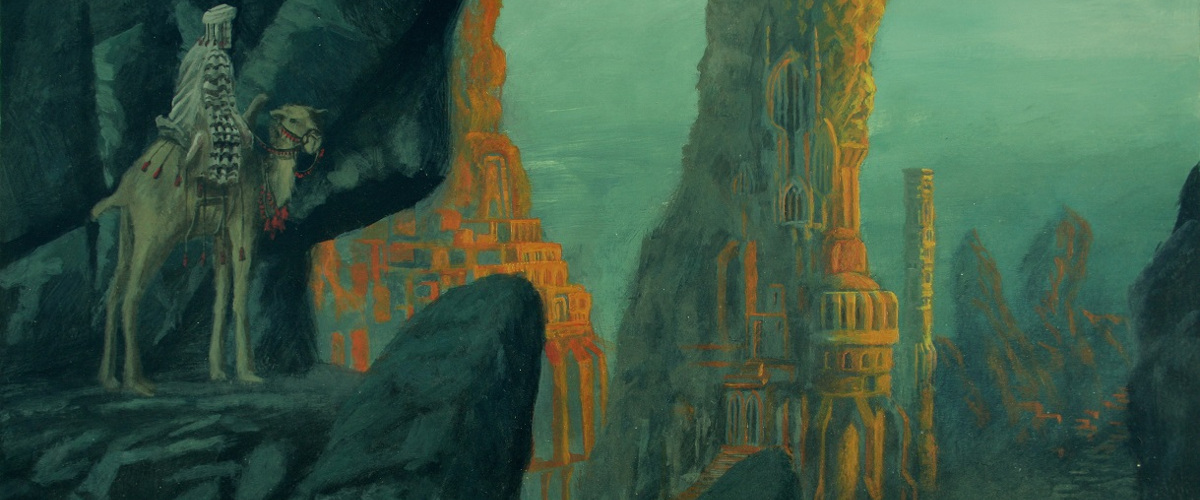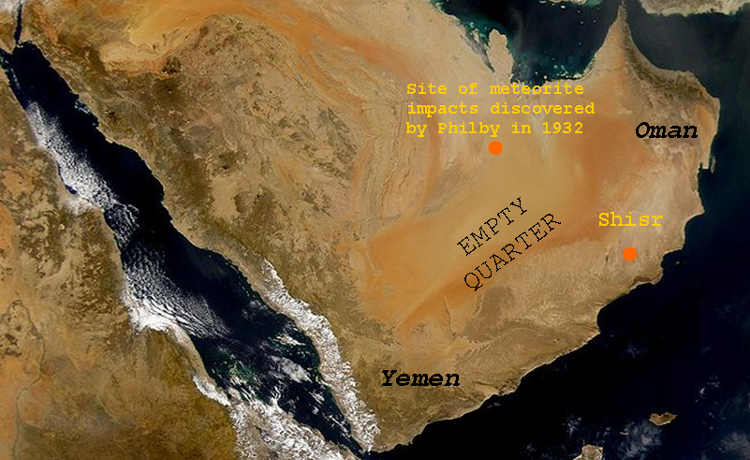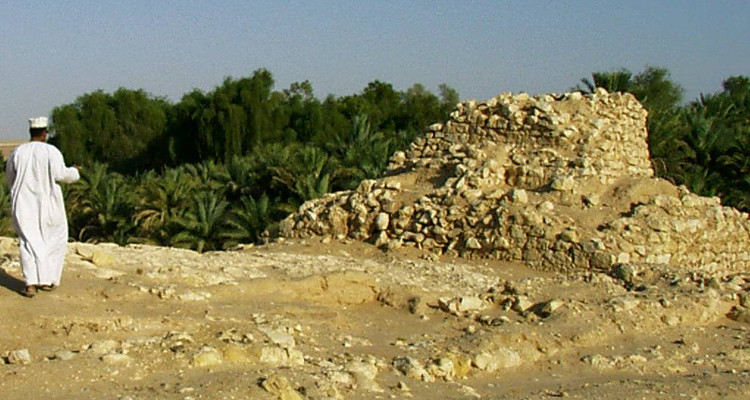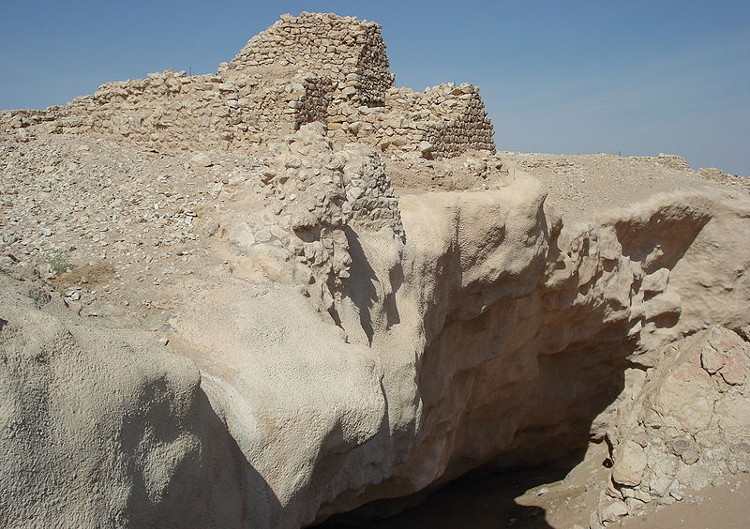
The Rub Al Khali Desert, also known as the Empty Quarter, is the largest sand desert in the world. It stretches across Saudi Arabia, Yemen, the United Arab Emirates and Oman.
Its name is very appropriate: apart from a few hardy Bedouin tribes with their camels, hardly anything survives in the Empty Quarter. Buried beneath the sand are probably some ruined cities that are only mentioned in old poems of the local nomads – one of them was discovered in 1992.
In the middle of the inhospitable Rub Al Khali desert, near a small oasis village called Shisr in Oman, a group of researchers led by amateur archaeologist and filmmaker Nicholas Clapp found ruins largely hidden under sand, which they identified as the fabled city of Ubar.

Satellite image of the Arabian Peninsula | © public domain
Ubar was built nearly 5,000 years ago. The city has been described as a processing and shipping center for frankincense, an aromatic resin grown on the nearby Quara Mountains. At that time, frankincense was as valuable as gold. It was highly valued by the Romans, Egyptians and other ancient civilizations and used in their rituals, among other things.
Today, frankincense is still a valuable commodity. The trees of the genus Boswellia, from which frankincense is extracted, are found only in some countries: Ethiopia, Yemen, Somalia, Oman and Sudan.
Clapp and his research partners suggest that Ubar is the same as the city of Iram mentioned in the Quran. According to the Quran, a people called ʿĀd inhabited this ancient city. They are said to have fallen away from the Islamic faith and worshipped idols. As a result, Allah had sent the Prophet Hūd to urge the ʿĀd to return to the worship of Allah.
The latter reacted with hostility and disregarded Hūd’s request. Allah is said not to have tolerated this: He sent a sandstorm over Iram that lasted seven nights and eight days, so that in the end the city disappeared under the sand and was forgotten.
Many researchers doubt that Iram was an actually existing city. They see this tradition merely as a moral tale to warn believers not to turn away from Allah.
Nicholas Clapp, who has been fascinated by the Arab world all his life, got the impetus for his search in 1992 after first reading about Ubar in the book Arabia Felix by British explorer Bertram Thomas.
Thomas, as well as the famous Lawrence of Arabia, whose plans for an exploratory expedition were interrupted by his death, wanted to locate the legendary city – but without success. Thomas Edward Lawrence, Lawrence of Arabia’s real name, even referred to Ubar as the Atlantis of the desert.
Report about Nicholas Clapp, who discovered the legendary city of Ubar in 1992
Clapp had a decisive advantage over Thomas and Lawrence: far more advanced technology. He convinced Jet Propulsion Laboratory scientists Charles Elachi and Ronald Blom to scan the region of the Arabian Peninsula where he suspected Ubar with a special shuttle radar system.
The radar system was able to “see” through the desert sands and identify geological features of the underlying soil. Ancient trade routes, perpetuated in the hard surface by hundreds of thousands of camels, were revealed.
Clapp considered the junctions where two or more of the ancient trade routes intersected to be the most promising search regions.
With these new findings, the small team of researchers recruited archaeologist Juris Zarins of Southwest Missouri State University and British explorer Sir Ranulph Fiennes.
The newly formed team went to Oman and searched 35 sites. They found ancient pottery sherds indicating trade routes, but no city.
In December 1992, Clapp and his fellow researchers returned to the Rub Al Khali Desert and began excavations at several sites – one of which was the oasis village of Shisr.
Ironically, Bertram Thomas had also been there on his expedition. He noticed the ruins of an old fort near the oasis village.
Residents told Thomas that the site had been built about 300 years ago by a local sheikh. Brief research seemed to confirm this – and so Thomas continued his expedition elsewhere.
Clapp’s team made further inquiries. The fort did indeed date from modern times, but it concealed other, much older remains that later turned out to be the Ubar they were looking for. They even found that some limestone blocks from Ubar were used to build the modern fort.
With the help of up to 40 volunteers at times, the group managed to uncover the remains of Ubar after months of excavation.

Excavation site of the ancient city of Ubar | © public domain
What they found was not a city as one would understand it in today’s sense. In the past, most Arabs lived in tents, where it was possible to open the sides to let in fresh air, rather than in proper dwellings. These tents, of course, leave few traces after such a long time. Accordingly, except for numerous fireplaces found, not much remains of most of the city.
In the center of the tent city was a fortress. This served the ruler of Ubar as a residence, as a processing and storage facility for incense, and as a record-keeping site.
In troubled times, the inhabitants of the entire city retreated to this fortress. The fortress was surrounded by eight walls, each about 0.6 m thick and 3 m to 3.60 m high. At each corner there was a tower about 3 m wide and 9 m high.
The fortress with its characteristic towers, unusual for that time, was a strong indication for the researchers that the ancient city of Ubar found was the legendary city of Iram of the Pillars mentioned in the Koran.
In the midst of the fortress complex is a huge hole in the ground, which took a large part of the inner buildings with it into the abyss. This also fits the stories of the Koran, in which the city of Iram was swallowed up by the sand after a cataclysmic event.

Hole in the ground amidst the ancient ruins | © username: 9591353082 in English Wikipedia / GFDL, CC-BY-SA-3.0 oder CC BY 2.5 / Wikimedia Commons / image cropped
No other strong evidence supporting the thesis that Ubar is the legendary city of Iram was found.
However, the research team did find some objects that date back to ancient times and indicate that the excavation site was used as a trading post in earlier times – possibly also for the incense trade. In addition to animal bones, including those of camels, they excavated ceramic fragments, coins and incense burners.
So far, they have not found any human bones. But this is not surprising, since Nicholas Clapp’s team has not yet searched at the bottom of the hole in the ground, where most of the victims – if there were any – are believed to have been buried.
Whether Ubar was the city of Iram of the Pillars mentioned in the Koran cannot be clearly clarified to this day. It is equally possible that the real Iram is still waiting to be discovered under the sands of Arabia – or that it is only a myth and never really existed.
Get a random article instead
Get a random article instead